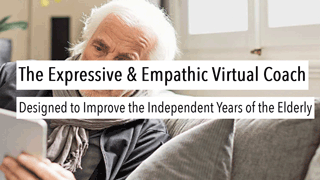
| Short descriptor of good practice |
| The EMPATHIC Research & Innovation project researched, innovated and validated new paradigms, laying the foundation for future generations of Personalized Virtual Coaches to help elderly people to live independently. The wellness coaching advice promoted healthy habits and behavior, by challenging each user to transform their personal goals and needs into actions. The EMPATHIC Virtual Coach (EMPATHIC-VC) engaged the healthy-senior user to take care of potential chronic diseases, maintain a healthy diet, have adequate physical activity as well as encourage social engagement, thus contributing to the older adults’ ability to maintain a satisfying and independent lifestyle. The EMPATHIC-VC motivated the user through a friendly virtual coach to reach pre-set benefits, whose achievement have been measured through project-defined metrics. The ambition was to create a personal, friendly and familiar environment for the users, avoiding the threatening effects of unfamiliar new gadgets or an excessive focus on medical supervision. The project looked beyond the basic medical and physical needs of a person, to the link between body and emotional well-being. The EMPATHIC-VC was capable of perceiving the emotional and social state of a person, in the learned context of the senior users’ expectations and requirements, and their personal history, and has responded adaptively to his/her needs. |
| Type of setting where good practice is delivered |
| Universities, NGO’s and public and private companies Non formal education Lifelong Learning |
| Time Frame for delivery of good practice |
| It was a 3-years research/scientific project in the field of HORIZON 2020. It developed innovative multimodal face and speech analytics, adaptive spoken dialogue systems, Intelligent computational models and natural human-computer interfaces, resulting in an emotionally-expressive virtual coach, designed to help aging users and their carers. Building upon neuroscience research, the project will use unobtrusive remote technologies to extract physiological markers of emotional states in real-time. The EMPATHIC-VC will monitor facial cues and speech style that underpin the user’s basic neural function, and will formulate online adaptive responses, facilitating interaction through mimicking, in turn promoting empathy and support with the user. |
| Type of learner the best practice is supporting |
| Seniors. |
| Resources used as part of good practice |
| http://www.empathic-project.eu/index.php/project-overview/ http://www.empathic-project.eu/index.php/publications/ http://www.empathic-project.eu/index.php/2021/03/27/empathic-virtual-coach-video/ |
| Aims and objectives of good practice |
| AMBITION Create a personal, friendly and familiar environment for the users, avoiding the threatening effects of unfamiliar new gadgets or an excessive focus on medical supervision. OUTCOMES This project developed innovative multimodal face and speech analytics, adaptive spoken dialogue systems, Intelligent computational models and natural human-computer interfaces, resulting in an emotionally-expressive virtual coach, designed to help aging users and their care takers. |
| Evidence as to why this was considered good practice |
| Part of a research Project under HORIZON2020. |
| 3 Key learning Principles that were used in this good practice to support senior learners |
| 1. Metacognition and Self-regulated Learning 2. Growth mindset 3. Inclusivity and accessibility |
| Any additional learning that we can take from this good practice example |
| To ensure an end-user driven design, EMPATHIC has involved senior users from the beginning and at each phase of the project, by considering their needs according to caregivers and professionals, by gathering initial data from them as well as their opinions regarding the technology developed, and by allowing them to use the personalized prototype from its first version to the final proof of concept. The proof-of-concept developed took care of data privacy in terms of secure storage, management and transmissions for user protection according to EU and national regulations. These technologies were demonstrated and validated in a series of clearly-defined realistic use cases representing different coaching goals and user profiles. A number of 200-250 seniors has been recruited in three European countries, Spain, Norway and France, representing different culture and lifestyle environments, resulting in a significant, representative sample of users involved the project. |
| Any Additional Information |
| / |
